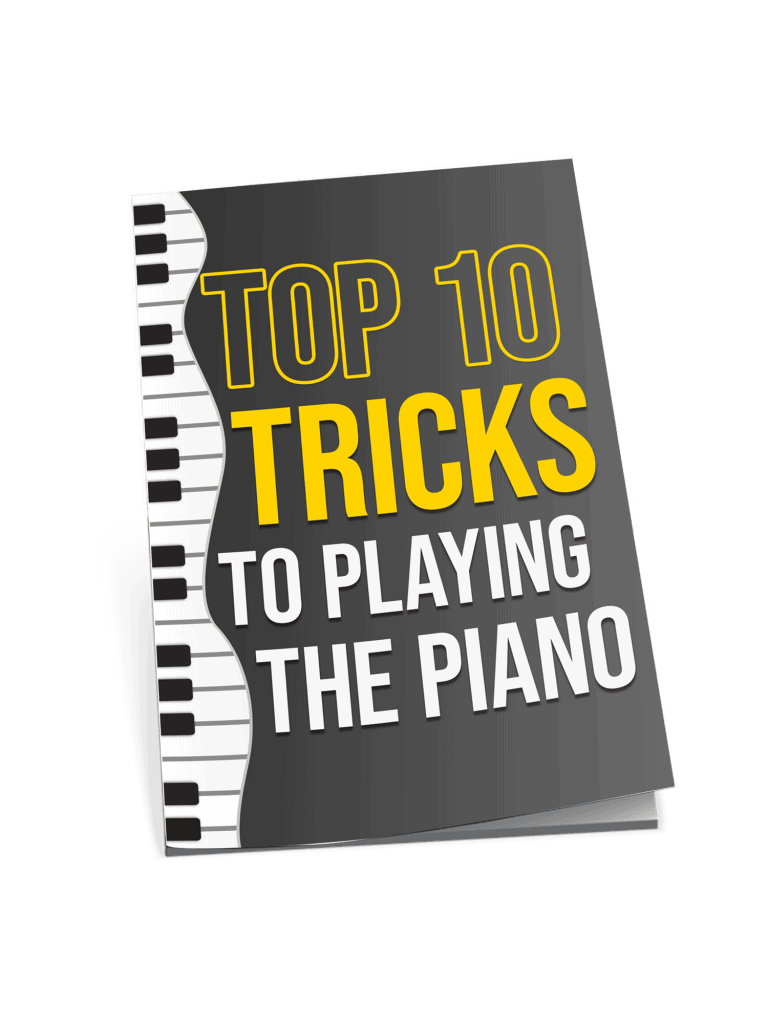Best
Beginner
Keyboard
-
Overall: Brand New Super Articulation Lite Voices
-
Best Feature: With 622 High-Quality Voices With Improved Sampling
-
TedScore™: 9/10
Best
Portable
Keyboard
-
Overall: SuperNATURAL Piano Sound Engine
-
Best Feature: 88-Key Weighted Keyboard
-
TedScore™: 9/10
Best
Keyboard for Live Performances
-
Overall: BEST KEYBOARD FOR LIVE PERFORMANCES
-
Best Feature: 88-Note Hammer-Action Piano. With Useful Educational Features
-
TedScore™: 8.5/10
Are you ready to unleash your inner Mozart and tickle the ivories like a pro? Have you ever asked yourself, “Can I learn piano on a keyboard?”
Well, you’re in luck because today, we’re diving into the exciting world of learning piano on a keyboard! And the big question is; can you learn piano on a keyboard?
In this blog post, we’ll explore the pros and cons of learning piano on a keyboard and provide some awesome tips and tricks to help you start your musical journey.
So grab your headphones and your favourite keyboard, and let’s get ready to rock the keys!
Differences Between a Piano and a Keyboard
Sound and Feel
While a keyboard can produce a wide range of sounds and effects, it can be difficult to replicate an acoustic piano’s rich, warm tones.
A piano produces sound with real strings and hammers, while a keyboard relies on digital samples and speakers. That being said, many modern digital keyboards are designed with high-quality sound engines and speakers that can come close to replicating the sound of a piano.
Now, let’s move on to feel.

The feel of an instrument is crucial for developing good technique and muscle memory. A piano has weighted keys, meaning the keys require varying amounts of pressure to play, depending on the note being played. This helps build strength and dexterity in the fingers and allows for more expression and dynamics in playing.
On the other hand, a keyboard may not have weighted keys or keys that feel lighter and less responsive than acoustic or digital pianos.
Key Size and Weight
If you’re serious about learning piano on a keyboard, you’ll want to ensure that your keyboard has at least 72 keys to play the most popular piano compositions.
Weighted keys are also important when choosing a keyboard for piano learning. Weighted keys simulate the feel of playing an acoustic piano by providing resistance when playing low notes and less resistance when playing high notes. This is because the strings for each note are slightly thinner and shorter in the treble register, becoming thicker and longer towards the bass register.

As a result, the keys on a grand piano keyboard are weighted differently.
If you’re starting out, you may not need weighted keys to learn the piano basics. However, as you progress, weighted piano keys will become increasingly important for developing proper finger strength and technique. Some keyboards have weighted keys, while others do not. If you’re serious about learning piano, it’s worth investing in a keyboard with weighted keys.
Polyphony and Other Features
When learning piano on a keyboard, it’s essential to understand the concept of polyphony. Polyphony refers to the number of notes that a keyboard can produce at the same time.
For instance, if you learn to play a 3-note chord with a 1-note melody, you would need a keyboard capable of producing at least 4-note polyphony. Many keyboards and sound modules have 64-note or even 128-note polyphony, which is more than enough for most players.
Other important features to consider when choosing a keyboard for learning piano include its range, physical feel, and sound replication. In my experience, a keyboard with weighted keys, high-quality samples, and a good sound engine can provide a more authentic and rewarding learning experience.
Is It Okay to Learn to Play Piano on the Keyboard?
It’s okay to take piano lessons and learn on a keyboard. Many people start learning on a keyboard before transitioning to a full-size piano. Basic piano skills (finger placement, hand posture, and reading sheet music) can all be learned on a keyboard.
It’s important to ensure that your keyboard has weighted keys, which means they simulate the feeling of playing on a real piano. Some keyboards even have touch sensitivity, which means that the keys respond to the strength at which you press them.
Did you know?
The first electronic keyboard instrument, the Hammond Organ, was invented in 1934 and became popular in jazz, blues, and rock music in the 1950s and 60s.

Advantages and Disadvantages of Learning Piano on a Keyboard
Learning to play the piano is a great hobby that can bring you hours of enjoyment and satisfaction, and it’s now easier than ever, thanks to traditional keyboards that mimic the look and feel of a real piano. One of the most significant advantages of learning to play the piano while on a keyboard is its affordability compared to an actual piano.
A quality electric keyboard can often be purchased in your local music store for much less than a comparable piano, making it a great way to get started without breaking the bank. Keyboards are much lighter and easier to move than pianos, making them ideal for practising in multiple locations.
However, there are also some disadvantages to learning on a keyboard. Firstly, they don’t offer the touch sensitivity of a real piano, meaning you won’t be able to play with the same level of expression and nuance that you would on a traditional instrument.
Secondly, practising on a keyboard can lead to poor habits when playing piano, such as not using correct finger placement or posture, which can be difficult to break when transitioning to a real piano.
Tips for Learning Piano on a Keyboard
1. Invest in a Quality Keyboard
Investing in a quality instrument is the first tip for learning piano on a keyboard. Look for a keyboard with weighted keys to help you develop proper finger strength and technique. I’ve recommended some really great models below.
Additionally, consider purchasing a keyboard with a sustained pedal, as this will allow you to create more expressive and dynamic playing.
2. Learn Proper Hand Position
Proper hand position is crucial when learning piano on a keyboard. Ensure your hands are positioned correctly on the keys, with your fingers curved and your wrists relaxed. You should also practice playing with the correct finger placement for each note, as this will help you develop muscle memory and improve your playing speed.
3. Utilize Online Resources
Many online resources, including video tutorials and instructional websites, are available for learning piano on a keyboard. Take advantage of these resources to learn new songs and techniques and get feedback on your playing from experienced piano instructors.
4. Practice Consistently
Practising consistently is one of the essential tips for learning piano on a keyboard. Set aside a regular time each day to practice, and focus on the areas where you need the most improvement. Remember, practice makes perfect!
5. Watch Video Tutorials
Watching video tutorials is a great way to learn new techniques and improve your playing skills. Look for tutorials covering various topics, including hand position, finger placement, and music theory. You can also find tutorials that teach you how to play chords for specific songs, which can be a great way to stay motivated and engaged in your practice.
Recommended Keyboards to Learn Piano
Here are some of our top recommended keyboards for learning piano:
One of my go-to recommendations is the Roland FP-30X.
The thing that sets it apart from other models is the PHA-4 Standard keyboard, which feels super realistic and responsive, making it a pleasure to express myself through music.
The only downside I’ve noticed is that it doesn’t have as many built-in sounds as some other keyboards, but for me, the incredible piano feel and sound totally make it worth buying!

PERFECT FOR: beginners and hobbyists
FEATURES: Brand new Super Articulation Lite voices
OTHER INFO: With 622 high-quality voices with improved sampling
Yamaha PSR E373 Portable Keyboard
When you check the price above, you’ll see there are loads of great places to buy this item. Our personal favorite is Gear4music.
It is the largest music retailer in the UK and fast becoming the most respected online music shop in the US too. Their customer service is excellent, they have competitive prices, really fast shipping, and usually have the longest guarantee.
Most professional musicians use Gear4music, so there is no reason why you shouldn’t too!
- Multiple lesson functions available for independent learning
- LCD display for easy navigation and control of your sound
- Free Yamaha Music School lessons and three months of Flowkey Premium available
- The speakers are somewhat underwhelming
- Polyphony is limited to only 48 notes
The professional musician who wrote this article combined many things,
from the product build, manufacturer’s reputation through to feedback
from other users, to create our famous TedScore™.

PERFECT FOR: beginner and intermediate players
FEATURES: 88-key weighted keyboard
OTHER INFO: SuperNATURAL piano sound engine
When you check the price above, you’ll see there are loads of great places to buy this item. Our personal favorite is Gear4music.
It is the largest music retailer in the UK and fast becoming the most respected online music shop in the US too. Their customer service is excellent, they have competitive prices, really fast shipping, and usually have the longest guarantee.
Most professional musicians use Gear4music, so there is no reason why you shouldn’t too!
- Versatile instrument with a variety of sounds and features
- Bluetooth connectivity
- With synthetic ivory-feel keys
- No lesson functions are available
The professional musician who wrote this article combined many things,
from the product build, manufacturer’s reputation through to feedback
from other users, to create our famous TedScore™.

PERFECT FOR: beginners
FEATURES: 88-note hammer-action piano. With useful educational features
OTHER INFO: Customisable layers and voices
When you check the price above, you’ll see there are loads of great places to buy this item. Our personal favorite is Gear4music.
It is the largest music retailer in the UK and fast becoming the most respected online music shop in the US too. Their customer service is excellent, they have competitive prices, really fast shipping, and usually have the longest guarantee.
Most professional musicians use Gear4music, so there is no reason why you shouldn’t too!
- Lets you play through headphones or speakers
- With adjustable settings for a more comfortable playing session
- None
The professional musician who wrote this article combined many things,
from the product build, manufacturer’s reputation through to feedback
from other users, to create our famous TedScore™.
Can You Learn Piano On A Keyboard?
Summary
So, can you learn to play piano on a keyboard? Definitely!
Learning piano on a keyboard can be a fantastic way to kickstart your musical journey and unleash your inner virtuoso! While it may not be like playing on a grand piano, it’s still a great way to build a solid foundation for your skills and have some fun along the way!
One of the coolest things about learning on a keyboard is that you can practice and play anywhere, anytime, without having to lug around a giant piano. Plus, keyboards often come with awesome features and effects that can take your playing to the next level, like recording capabilities and cool sound effects.
But not all keyboards are created equal, so if you’re serious about becoming a piano master, investing in a keyboard with weighted keys and pedals that mimic a real piano’s feel and sound is best.
Key Points:
- Keyboard Types: Not all keyboards are created equal. Some have 88 keys like a real piano, while others have fewer.
- Weighted Keys: Look for keyboards with weighted keys for a more authentic piano feel.
- Pedals: Having pedals can make a big difference in your learning experience.
- Digital Pianos: A digital piano is a worthwhile investment if you can afford it.
Above all, the key to success is practising, practising, practising, and staying motivated to achieve your goals. With hard work and dedication, you can become an amazing pianist and unlock the many joys and benefits of making music!
Wait, there’s more!!!
Looking for the perfect keyboard or digital piano to take your playing to the next level? Look no further than our list of the 15 Best Keyboard Pianos And Digital Pianos, featuring a range of instruments for every skill level and budget!
FAQ's
Yes, a keyboard can be a good option to learn piano, especially if you’re a beginner or have limited space or budget. However, keep in mind that there are some limitations to learning on a keyboard, such as the lack of weighted keys and touch sensitivity.
A keyboard and a piano can be good options for beginners, but it depends on your preferences and circumstances. A keyboard may be a more practical choice if you have limited space or budget. However, if you’re serious about learning and have the means to invest in a piano, it may offer a more authentic and rewarding experience.
Learning on a keyboard may be easier in some ways, as they often come with features like built-in lessons and metronomes. However, remember that the lack of weighted keys and touch sensitivity on most keyboards can make developing proper technique and expression your first keyboard, more challenging.
To learn piano as an adult, start by finding a qualified teacher or online course to guide you through the basics. Practice regularly, set achievable goals, and be patient with yourself as you develop your skills.
A keyboard is an electronic instrument that can produce a variety of sounds, including piano sounds, while a piano is an acoustic instrument that produces sound by striking strings with hammers. Keyboards are generally more portable and affordable than pianos, but they may not offer the same level of sound quality or touch sensitivity as a high-quality piano.












While the article by Robert Emery does provide some helpful insights on the differences between pianos and keyboards, I can’t help but feel that it slightly oversimplifies the complexity of the learning experience. The tactile feedback from a piano, the nuanced acoustics, and the mechanical response of each key press offer a profoundly unique experience. However, it’s equally important to recognize the technological advancements and versatility of keyboards, which offer a range of sounds and effects that are not available on a traditional piano. This debate isn’t just about the technicalities of instruments but also about the accessibility and practicalities of music education today. Isn’t it more critical to encourage engagement with music in whatever form available, rather than positing one instrument as superior for learning?
You’re correct Theophilus. However, it’s just a fast guide to answer the simple question of ‘can you learn piano on a keyboard’.
hey, so reading about the tips for learning piano on a keyboard really made me think. i’ve been using an old keyboard to practice on and never really thought much about the quality affecting my learning. Robert Emery brought up some interesting points there. guess it’s time to start saving up for something better. anyone got suggestions for keyboards that won’t break the bank but still good for learning?
Thanks TJ for the recommendation! Do you think these models are suitable for absolute beginners too?
Mikey, you might want to check out some of the mid-range Yamahas or Casios. They offer pretty decent weighted key action and sound quality without costing too much. Make sure to try them out in person if you can, it really makes a difference in finding the right fit for you.
After reading through the segment on whether it’s okay to learn piano on a keyboard, I find myself reflecting on the nuanced differences highlighted by Robert Emery regarding sound and the tangible experience of playing on a traditional piano versus a modern keyboard. Given the emphasis on tactile response from weighted keys on an acoustic piano, I’m curious how much of a detraction from the learning experience is to be expected if one opts for a keyboard? Furthermore, are there specific keyboard models that Robert or anyone else would recommend, which closely mimic the feel and response of an acoustic piano?
Look at the Digital Piano Buyer’s Guide.